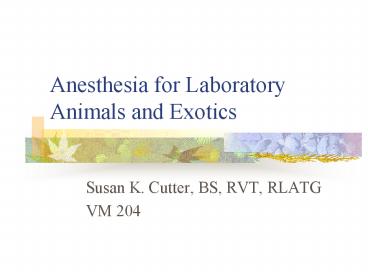Anesthesia for Laboratory Animals and Exotics - PowerPoint PPT Presentation
1 / 17
Title:
Anesthesia for Laboratory Animals and Exotics
Description:
Guinea Pig. 5-10ml. 0.3ml. 10-15ml. 0.5ml. Rabbit. 30-50ml. 0.5-3ml. Not recommended. 1-5ml ... Guinea Pigs. Are difficult to intubate because of pharyngeal anatomy. ... – PowerPoint PPT presentation
Number of Views:780
Avg rating:3.0/5.0
Title: Anesthesia for Laboratory Animals and Exotics
1
Anesthesia for Laboratory Animals and Exotics
- Susan K. Cutter, BS, RVT, RLATG
- VM 204
2
Overview
- General overview and considerations of laboratory
and exotic anesthesia - Drug volumes that can be injected
- Specific drugs for specific species
- Dosage calculation examples
- Questions/Discussion
3
What is anesthesia?
- A state of unconsciousness induced in an animal.
4
3 Components of Anesthesia
- Analgesia pain relief
- Amnesia loss of memory
- Immobilization
5
General Considerations
- Some species used extensively
- They are used more so there is more information
available to research different anesthetic
options - Some species rarely used
- May need to find a person who has experience with
these animals to get information about what does
and does not work for anesthetic options - Differing anatomy and physiology
- Size of species versus metabolism
- Dangerous or free-ranging species
6
Factors that cannot be assessed at a distance
- Nutrition
- Disease
- Parasite load
- Infection
- Estrus
- Pregnancy
- Lactation
7
Metabolism
- Smaller sized mammals have faster metabolism
- Need to consider when deciding what drugs to use
and how fast they are eliminated from the body
8
Techniques to use in anesthesia
- Accurate body weight
- Minimizing stress
- Withhold feed
- Large Animals 12 hours
- Small Animals (hedgehogs, sugar gliders,
chinchillas 2 hours - Rodents and Rabbits not necessary
- Intubation
9
Techniques to use in anesthesiacontd
- Assist respiration
- Maintain body temperature
- Blankets
- Drapes
- Circulating water heating pads
- Limited clipping of hair
- Warmed fluids
- IV catheters
10
Techniques to use in anesthesiacontd
- Supplemental fluids to correct for blood loss of
dehydration - 3 times the volume of blood lost
- Can be given IV
- Other routes to be given are IP or SQ
- Fluids during anesthesia
- 10ml/kg/hr
11
Techniques to use in anesthesiacontd
- Monitor cardiovascular function
- MMC and CRT
- Heart rate
- Heart rhythm
- Pulse rate
- Pulse pressure
- Blood pressure
- ECG
12
Techniques to use in anesthesiacontd
- Monitor reflexes
- Palpebral light if they are blinking
- Corneal stops blinking if too deep or dead ?
- Toe-pinch pulls away if light and is feeling
pain - Muscle tone
13
Dosage Concerns
- What is a major concern that must be considered
when figuring out dosages and concentrations to
use? - SIZE OF THE ANIMAL
- If an animal is the size of a rabbit or larger,
you can use the prepared concentration of drugs - If an animal is smaller, you will almost always
have to dilute the drugs.
14
Recommended volumes for injections
15
Anesthetic considerations for specific species
- Rabbits
- Easily frightened
- Difficult to intubate
- In dorsal recumbency, abdominal viscera may
interfere with diaphragm movement and venous
return
16
Anesthetic considerations for specific species
- Guinea Pigs
- Are difficult to intubate because of pharyngeal
anatomy. Soft palate is continuous with the base
of the tongue which is why the glottis cannot be
visualized. - Large cecum which contains 65 of the
gastrointestinal contents
17
Anesthetic considerations for specific species
- Hamsters
- Cheek pouches
- Biters
- Others
- Zebras are equines, but dont always use the
same doses as domestic equines for anesthesia - Research species before anesthetizing































